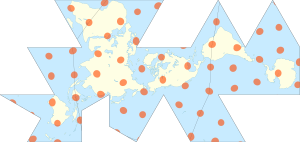
Back Mapa Dymaxion Catalan Χάρτης Dymaxion Greek Mapa Dymaxion Spanish Dymaxion mapa Basque Projection de Fuller French היטל פולר HE डायमैक्सियम नक्शा Hindi Fuller-vetület Hungarian Peta Dymaxion ID Proiezione di Fuller Italian





The Dymaxion map or Fuller map is a projection of a world map onto the surface of an icosahedron, which can be unfolded and flattened to two dimensions. The flat map is heavily interrupted in order to preserve shapes and sizes.
The projection was invented by Buckminster Fuller. The March 1, 1943, edition of Life magazine included a photographic essay titled "Life Presents R. Buckminster Fuller's Dymaxion World". The article included several examples of its use together with a pull-out section that could be assembled as a "three-dimensional approximation of a globe or laid out as a flat map, with which the world may be fitted together and rearranged to illuminate special aspects of its geography".[1] Fuller applied for a patent in the United States in February 1944, showing a projection onto a cuboctahedron, which he called "dymaxion". The patent was issued in January 1946.[2]
In 1954, Fuller and cartographer Shoji Sadao produced the Airocean World Map, a version of the Dymaxion map that used a modified but mostly regular icosahedron as the base for the projection. The version most commonly referred to today, it depicts Earth's continents as "one island", or nearly contiguous land masses.
The Dymaxion projection is intended only for representations of the entire globe. It is not a gnomonic projection, whereby global data expands from the center point of a tangent facet outward to the edges. Instead, each triangle edge of the Dymaxion map matches the scale of a partial great circle on a corresponding globe, and other points within each facet shrink toward its middle, rather than enlarging to the peripheries.[3] Fuller's 1980 version of the Dymaxion map was the first definition and use of a mathematical transformation process to make the map.[4][5][6][7] It is a polyhedral map projection.
The name Dymaxion was applied by Fuller to several of his inventions.
- ^ "Life Presents R. Buckminster Fuller's Dymaxion World". LIFE. 1 March 1943. pp. 41–55.
- ^ U.S. patent 2,393,676
- ^ Fuller, Ideas and Integrities (1969 ed., p. 139).
- ^ Gray, Robert W. (1994-01-01). "Fuller's Dymaxion Map". Cartography and Geographic Information Systems. 21 (4): 243–246. doi:10.1559/152304094782540628 (inactive 31 January 2024). ISSN 1050-9844.
{{cite journal}}: CS1 maint: DOI inactive as of January 2024 (link) - ^ Gray, Robert W. (1995-10-01). "Exact Transformation Equations for Fuller's World Map". Cartographica: The International Journal for Geographic Information and Geovisualization. 32 (3): 17–25. doi:10.3138/1677-3273-Q862-1885. ISSN 0317-7173.
- ^ Crider, John E. (2008-03-01). "Exact Equations for Fuller's Map Projection and Inverse". Cartographica: The International Journal for Geographic Information and Geovisualization. 43 (1): 67–72. doi:10.3138/carto.43.1.67. ISSN 0317-7173.
- ^ "Dymaxion Map Transformations - Technical White Paper", Kitrick, Christopher, 2018
